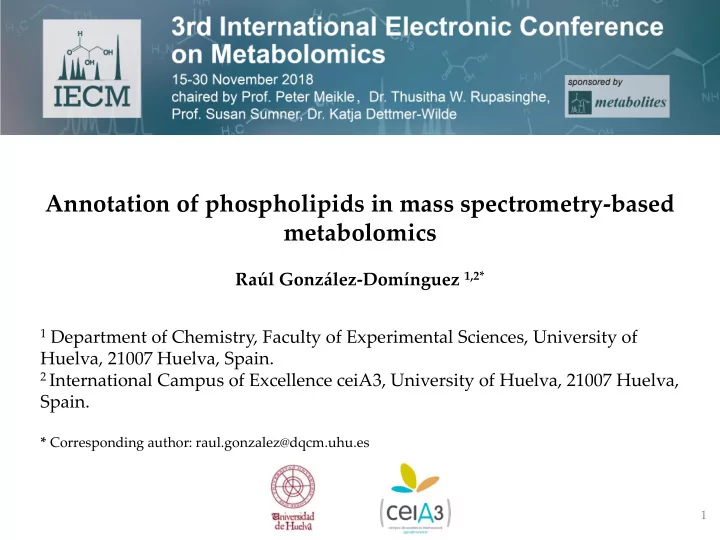

Annotation of phospholipids in mass spectrometry-based metabolomics Raúl González-Domínguez 1,2* 1 Department of Chemistry, Faculty of Experimental Sciences, University of Huelva, 21007 Huelva, Spain. 2 International Campus of Excellence ceiA3, University of Huelva, 21007 Huelva, Spain. * Corresponding author: raul.gonzalez@dqcm.uhu.es 1
Annotation of phospholipids in mass spectrometry- based metabolomics 184.073 104.107 496.339 478.330 2
Abstract: Phospholipids play numerous roles in biological systems, including the formation of membrane lipid bilayers and the signaling of multiple biological pathways, so that their dyshomeostasis have been associated with the development of multiple diseases, such as Alzheimer’s disease and cancer. Metabolomics based on mass spectrometry has been largely employed to investigate these disease-related perturbations in the phospholipidome. However, the annotation of discriminant features still remains as a major bottleneck in the metabolomic pipeline. Chemical standards of individual phospholipid species are normally not commercially available due to the large number of isomers, so the knowledge of their characteristic fragmentation patterns upon tandem mass spectrometry is of great utility for their annotation. In this work, we provide a simplified guideline for the MS/MS-based identification of the most important phospholipid classes and their fatty acid composition. Keywords: phospholipids; mass spectrometry; annotation 3
Introduction Phospholipids play pivotal roles in biological systems Formation of cellular phospholipids membranes Anchorage of integral phospholipases membrane proteins lysophospholipids platelet activating factors diacylglycerides fatty acids eicosanoids Precursor of lipid mediators (neural cell homeostasis, immune responsiveness, oxidative stress, neuroinflammation) 4
Introduction Numerous diseases elicit abnormal phospholipid homeostasis • Alzheimer’s disease • Parkinson’s disease • Cancer Phospholipids and related metabolites have a great potential to elucidate pathological hallmarks associated with diseases and to discover candidate diagnostic biomarkers Metabolomics and Lipidomics 5
Introduction 3) Data processing & 1) Sample preparation 2) Analysis 4) Annotation statistical analysis • Various analytical platforms can be employed to characterize the phospholipidome • Annotation of phospholipids is a major bottleneck in the metabolomic pipeline 5) Biological interpretation 6
Results and Discussion MS-based characterization of the phospholipidome Direct Mass Spectrometry Liquid chromatography Mass Spectrometry PL LPL Short analysis time Reduced matrix effects Wide coverage Separation of isomers 7
Results and Discussion MS-based characterization of the phospholipidome ESI+ ESI- [M-H] - , [M-CH 3 ] - , [M+Cl] - , Phosphatidylcholines (PC) [M+H] + , [M+Na] + , [M+K] + [M+FA] - [M+H] + , [M+Na] + [M-H] - Phosphatidylethanolamines (PE) [M-H] - Phosphatidylinositols (PI) - [M+H] + [M-H] - Phosphatidylserines (PS) [M+H] + [M-H] - Phosphatidylglycerols (PG) [M-H] - Phosphatidic acids (PA) - Table 1. Major adducts detected upon electrospray ionization 8
Results and Discussion Annotation of phospholipids ESI+ ESI- 184.07, 104.11, 86.09 168.04 [m/z-59] + [m/z-60] - for [M+FA] Phosphatidylcholines (PC) [M+H-183] + , [M+Na-205] + , [m/z-50] - for [M+Cl] [M+K-221] + [M+H-141] + , [M+Na-163] + Phosphatidylethanolamines (PE) 196.04 Phosphatidylinositols (PI) - 241.02 [M+H-185] + [M-H-87] - Phosphatidylserines (PS) [M+H-171] + Phosphatidylglycerols (PG) 171.03 Phosphatidic acids (PA) - 153 Table 2. Characteristic ions upon MS/MS fragmentation for each phospholipid class 9
Results and Discussion Annotation of phospholipids MS/MS fragmentation in the positive ionization mode m/z Fatty acid ion B ion C Lauric acid 257.212 183.175 Myristic acid 285.243 211.206 Palmitoleic acid 311.259 237.222 Palmitic acid 313.274 239.237 Linolenic acid 335.259 261.222 Linoleic acid 337.274 263.237 Oleic acid 339.290 265.253 Stearic acid 341.306 267.269 Araquidic acid 369.337 295.300 Eicosapentaenoic acid 359.259 285.222 Araquidonic acid 361.274 287.237 Docosahexaenoic acid 385.274 311.237 10
Results and Discussion Annotation of phospholipids MS/MS fragmentation in the negative ionization mode m/z RCOO - Fatty acid Lauric acid 199.170 Myristic acid 227.201 Palmitoleic acid 253.217 Palmitic acid 255.232 Linolenic acid 277.217 Linoleic acid 279.232 Oleic acid 281.248 Stearic acid 283.264 Araquidic acid 311.295 Eicosapentaenoic acid 301.217 Araquidonic acid 303.232 Docosahexaenoic acid 327.232 11
Conclusions MS-based metabolomics provides wide coverage of the phospholipidome Phospholipids show characteristic fragmentation patterns upon ESI-MS analysis, thus facilitating their annotation Depending on the phospholipid class, characteristic daughter ions are detected in the positive and negative ion modes MS/MS breakage of ester bonds between fatty acids and the glycerol backbone allows identifying the fatty acid composition of phospholipids 12
Recommend
More recommend